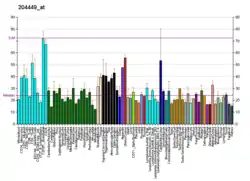Phosducin-like
Phosducin-like protein is a protein that in humans is encoded by the PDCL gene.[5][6]
Phosducin-like protein is a putative modulator of heterotrimeric G proteins. The protein shares extensive amino acid sequence homology with phosducin, a phosphoprotein expressed in the retina and pineal gland. Both phosducin-like protein and phosphoducin have been shown to regulate G-protein signaling by binding to the beta-gamma subunits of G proteins.[6]
References
- GRCh38: Ensembl release 89: ENSG00000136940 - Ensembl, May 2017
- GRCm38: Ensembl release 89: ENSMUSG00000009030 - Ensembl, May 2017
- "Human PubMed Reference:". National Center for Biotechnology Information, U.S. National Library of Medicine.
- "Mouse PubMed Reference:". National Center for Biotechnology Information, U.S. National Library of Medicine.
- Thibault C, Feng Wang J, Charnas R, Mirel D, Barhite S, Miles MF (May 1999). "Cloning and characterization of the rat and human phosducin-like protein genes: structure, expression and chromosomal localization". Biochim Biophys Acta. 1444 (3): 346–54. doi:10.1016/S0167-4781(99)00006-8. PMID 10095058.
- "Entrez Gene: PDCL phosducin-like".
Further reading
- Miles MF, Barhite S, Sganga M, Elliott M (1993). "Phosducin-like protein: an ethanol-responsive potential modulator of guanine nucleotide-binding protein function". Proc. Natl. Acad. Sci. U.S.A. 90 (22): 10831–5. doi:10.1073/pnas.90.22.10831. PMC 47872. PMID 8248177.
- Lazarov ME, Martin MM, Willardson BM, Elton TS (1999). "Human phosducin-like protein (hPhLP) messenger RNA stability is regulated by cis-acting instability elements present in the 3'-untranslated region". Biochim. Biophys. Acta. 1446 (3): 253–64. doi:10.1016/S0167-4781(99)00098-6. PMID 10524200.
- Ruiz-Gómez A, Humrich J, Murga C, et al. (2000). "Phosphorylation of phosducin and phosducin-like protein by G protein-coupled receptor kinase 2". J. Biol. Chem. 275 (38): 29724–30. doi:10.1074/jbc.M001864200. PMID 10884381.
- Lazarov ME, Martin MM, Willardson BM, Elton TS (2000). "Molecular cloning and characterization of the human phosducin-like protein (hPhLP) promoter". Biochim. Biophys. Acta. 1492 (2–3): 460–4. doi:10.1016/S0167-4781(00)00137-8. PMID 10899582.
- Hartley JL, Temple GF, Brasch MA (2001). "DNA cloning using in vitro site-specific recombination". Genome Res. 10 (11): 1788–95. doi:10.1101/gr.143000. PMC 310948. PMID 11076863.
- Wiemann S, Weil B, Wellenreuther R, et al. (2001). "Toward a catalog of human genes and proteins: sequencing and analysis of 500 novel complete protein coding human cDNAs". Genome Res. 11 (3): 422–35. doi:10.1101/gr.GR1547R. PMC 311072. PMID 11230166.
- Simpson JC, Wellenreuther R, Poustka A, et al. (2001). "Systematic subcellular localization of novel proteins identified by large-scale cDNA sequencing". EMBO Rep. 1 (3): 287–92. doi:10.1093/embo-reports/kvd058. PMC 1083732. PMID 11256614.
- McLaughlin JN, Thulin CD, Hart SJ, et al. (2002). "Regulatory interaction of phosducin-like protein with the cytosolic chaperonin complex". Proc. Natl. Acad. Sci. U.S.A. 99 (12): 7962–7. doi:10.1073/pnas.112075699. PMC 123003. PMID 12060742.
- Humrich J, Bermel C, Grubel T, et al. (2003). "Regulation of phosducin-like protein by casein kinase 2 and N-terminal splicing". J. Biol. Chem. 278 (7): 4474–81. doi:10.1074/jbc.M206347200. PMID 12466282.
- Strausberg RL, Feingold EA, Grouse LH, et al. (2003). "Generation and initial analysis of more than 15,000 full-length human and mouse cDNA sequences". Proc. Natl. Acad. Sci. U.S.A. 99 (26): 16899–903. doi:10.1073/pnas.242603899. PMC 139241. PMID 12477932.
- Gerhard DS, Wagner L, Feingold EA, et al. (2004). "The status, quality, and expansion of the NIH full-length cDNA project: the Mammalian Gene Collection (MGC)". Genome Res. 14 (10B): 2121–7. doi:10.1101/gr.2596504. PMC 528928. PMID 15489334.
- Wiemann S, Arlt D, Huber W, et al. (2004). "From ORFeome to biology: a functional genomics pipeline". Genome Res. 14 (10B): 2136–44. doi:10.1101/gr.2576704. PMC 528930. PMID 15489336.
- Carter MD, Southwick K, Lukov G, et al. (2005). "Identification of phosphorylation sites on phosducin-like protein by QTOF mass spectrometry". J Biomol Tech. 15 (4): 257–64. PMC 2291704. PMID 15585822.
- Humrich J, Bermel C, Bünemann M, et al. (2005). "Phosducin-like protein regulates G-protein betagamma folding by interaction with tailless complex polypeptide-1alpha: dephosphorylation or splicing of PhLP turns the switch toward regulation of Gbetagamma folding". J. Biol. Chem. 280 (20): 20042–50. doi:10.1074/jbc.M409233200. PMID 15745879.
- Lukov GL, Hu T, McLaughlin JN, et al. (2005). "Phosducin-like protein acts as a molecular chaperone for G protein betagamma dimer assembly". EMBO J. 24 (11): 1965–75. doi:10.1038/sj.emboj.7600673. PMC 1142607. PMID 15889144.
- Rual JF, Venkatesan K, Hao T, et al. (2005). "Towards a proteome-scale map of the human protein-protein interaction network". Nature. 437 (7062): 1173–8. doi:10.1038/nature04209. PMID 16189514. S2CID 4427026.
- Mehrle A, Rosenfelder H, Schupp I, et al. (2006). "The LIFEdb database in 2006". Nucleic Acids Res. 34 (Database issue): D415–8. doi:10.1093/nar/gkj139. PMC 1347501. PMID 16381901.
- Lukov GL, Baker CM, Ludtke PJ, et al. (2006). "Mechanism of assembly of G protein betagamma subunits by protein kinase CK2-phosphorylated phosducin-like protein and the cytosolic chaperonin complex". J. Biol. Chem. 281 (31): 22261–74. doi:10.1074/jbc.M601590200. PMID 16717095.
- Olsen JV, Blagoev B, Gnad F, et al. (2006). "Global, in vivo, and site-specific phosphorylation dynamics in signaling networks". Cell. 127 (3): 635–48. doi:10.1016/j.cell.2006.09.026. PMID 17081983. S2CID 7827573.
This article is issued from Wikipedia. The text is licensed under Creative Commons - Attribution - Sharealike. Additional terms may apply for the media files.





